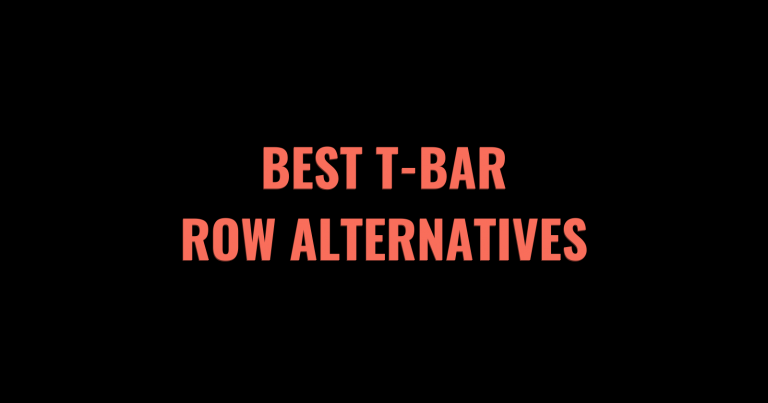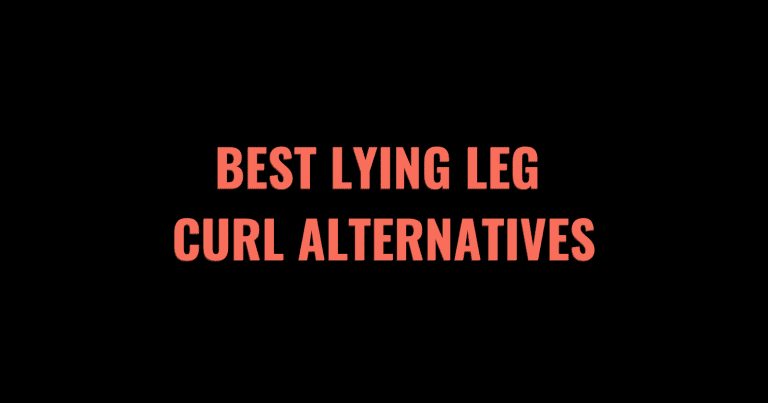When leg day rolls around, deadlifts and squats often steal the show. But accessory lifts like the lunge shouldn’t be underestimated.
Lunges are fantastic for improving stability, evening out your left and right lower body’s strength, improving coordination, and burning fat. They are also effective at sculpting the muscles in your posterior chain for chiseled hamstrings and glutes.
Unfortunately, for some lifters, lunges can cause or exacerbate knee pain or injury. Others may lack the balance and coordination required to do lunges safely and effectively.
Luckily, there are plenty of alternative exercises to the lunge that provide similar benefits. Here is our list of the 9 best alternative exercises to lunges.
Table of Contents
- 1 The 9 Best Lunge Alternatives
- 2 Reasons to Choose a Lunge Alternative
- 3 Muscles Worked by Lunges
- 4 Lunge Alternatives: FAQs
- 5 Other Alternative Exercises
- 5.1 The 10 Best Leg Extension Alternatives
- 5.2 The 10 Best Bench Press Alternatives
- 5.3 The 8 Best Ab Rollout Alternatives
- 5.4 The 10 Best Bent Over Row Alternatives
- 5.5 The 10 Best Lat Pulldown Alternatives
- 5.6 The 10 Best Dumbbell Pullover Alternatives
- 5.7 The 10 Best Plank Alternatives
- 5.8 The 8 Best Hammer Curl Alternatives
- 5.9 The 9 Best T-Bar Row Alternatives
- 5.10 The 8 Best Tricep Dip Alternatives
- 5.11 The 10 Best Pallof Press Alternatives
- 5.12 The 9 Best Pendlay Row Alternatives
- 5.13 The 10 Best Lying Leg Curl Alternatives
- 5.14 The 10 Best Bulgarian Split Squat Alternatives
- 5.15 The 10 Best Hack Squat Alternatives
The 9 Best Lunge Alternatives
- Split Squats
- Step-Ups
- Box Squats
- Reverse Lunges
- Sled Pulls
- Goblet Squats
- Unilateral Leg Presses
- Unilateral Romanian Deadlifts
- Bulgarian Split Squats
1. Split Squats
When to Perform Split Squats
Split squats are very similar to lunges, except your feet do not move. In a lunge, the feet step into a staggered position for each rep. In a split squat, the feet remain static as your legs lower and lift the weight. Split squats may be more comfortable for people experiencing knee pain when performing front lunges. People struggling with balance during a lunge also find the split squat to be easier.
How to Perform Split Squats
- If you are using weight for the exercise, prepare for the movement by loading a barbell across your shoulders or holding dumbbells or kettlebells at your sides.
- Stand with your feet together, your back straight, and your gaze looking forward.
- Stagger your stance by taking a big step forward, keeping your toes in line with your knees.
- Brace your abdominals and bend at the knees to lower your body towards the ground. Stop descending when your back knee is close to the ground, but your front knee is still behind your toes.
- Keep your feet where they are and push through the back foot to lift yourself back up to your starting position.
- Pause without moving the feet before lowering again.
- Repeat for the desired number of reps. Reset by stepping your feet back together and then repeat on the opposite leg.
For a visual aid, check out this video from the University of Bristol demonstrating the correct form for a standard split squat.
Tips for Split Squats
Pay close attention to your foot spacing to ensure the weight is primarily loaded onto your front leg. Push through the ball of your front foot when ascending, and ensure your hips and feet point forward throughout each rep.
2. Step-Ups
When to Perform Step-Ups
Step-ups engage the same muscle groups as a lunge, making them a great alternative. Stepping up during a step up rather than forward during a lunge places less strain upon the knees. Step-ups involve pushing down through your working leg against gravity, giving you a greater range of motion and helping you keep your front shin vertical to avoid injury. You can do this exercise with dumbbells, kettlebells, a barbell, or just your body weight.
How to Perform Step-Ups
- If you are using weight for the exercise, prepare for the movement by loading a barbell across your shoulders or holding dumbbells or kettlebells at your sides.
- Stand in front of a stable flat bench, box, or another secure platform. Choose a platform height you can step onto safely without losing your balance. You should be able to maintain an upright spine and neutral pelvis when stepping onto the platform.
- Tuck your chin and gaze straight ahead to protect your upper spine. Brace your abdominals and pre-tension your legs and glutes.
- Place one foot on the platform. Ensure your knee doesn’t move in front of your toes and your leg is bent to 90 degrees. Push evenly throughout your entire foot.
- Push down into your elevated foot to lift your back leg off the floor. Squeeze your quads and glutes to complete the exercise. Both feet should be on the platform.
- Maintain a strong core and neutral spine as you reverse the exercise. Bend your knees and soften your hips and ankles as you step down from the platform.
- Repeat on the same side or alternate legs for each rep.
- Perform an even amount of reps and sets per side.
For a visual aid, check out this video demonstrating the correct form for a weighted step-up.
Tips for Step-Ups
Your front leg should do all of the work for this lunge alternative. Your back leg should trail behind you without pressing off the floor to assist the exercise. Tilt your torso forward slightly to keep your weight centered on your front foot.
3. Box Squats
When to Perform Box Squats
Box squats are popular among lifters of all experience levels. For beginners, they are a great, knee-friendly way to lift heavy weights. Advanced lifters find them useful for building explosive strength for coming out of the bottom of a squat. Lifters select their preferred range of motion by varying the height of the box or platform. Sitting on a box eliminates bouncing or momentum, protects your knees, and forces you to use explosive strength to lift the weight.
How to Perform Box Squats
- Set up a barbell in a squat rack or smith machine at a height just below your shoulders.
- Place a plyometric box or flat bench a few feet behind the rack. Check that the height allows you to bend your knees to 90 degrees when seated.
- Face the barbell with the box behind you. Grab the barbell with a pronated grip and your hands just outside shoulder-width.
- Step underneath the barbell and unrack it. It should rest on your upper back muscles. Step backwards so you are a few inches in front of your platform.
- Stand tall with your feet spaced just wider than hip-width and a soft bend in your knees.
- Tuck your chin, brace your abdominals and grip the floor with your feet. Retract your shoulder blades and tense your legs.
- Bend your hips, knees, and ankles to squat down while keeping an upright spine. Stop when your glutes make contact with the platform.
- Pause for 1-2 seconds on the platform to eliminate your momentum.
- Push through all four corners of your feet and squeeze your glutes and legs to begin the ascent. Extend your knees as you come up.
- Lock out the squat by extending your hips and squeezing your legs and glutes while keeping a neutral spine.
- Repeat for the desired number of reps and sets.
Check out this video from Squat University for a visual guide to performing the weighted box squat.
Tips for Box Squats
Finish each box squat rep by pushing your hips forward. Your pelvis should be tucked with your hip bones pointing forward and up. Failure to tuck your pelvis in this exercise can lead to a swayed lower back and put excess strain on your lumbar spine.
4. Reverse Lunges
When to Perform Reverse Lunges
Reverse lunges are a knee-friendly variation of the standard forward lunge. They are the closest alternative to forward lunges and involve stepping backward for each lunge rep. Stepping backward takes a lot of pressure off the knee as it doesn’t have to use shearing or braking force to stop forward momentum. Reverse lunges emphasize your glute medius and hamstrings, while forward lunges focus more on your quads. If you want to isolate your posterior chain and protect your knees while lunging, the reverse lunge is a great choice.
How to Perform Reverse Lunges
- If you are using weight, prepare for the movement by loading a barbell across your shoulders or holding dumbbells or kettlebells at your sides.
- Stand with your feet together, your back straight, and your gaze looking forward.
- Distribute your weight evenly and grip the floor with your feet for a stable foundation.
- Brace the core, glutes, and legs. Take a big step backward while bending your knees, hips and ankles.
- Lower yourself towards the floor until your back knee hovers about an inch off the floor and both legs are bent to 90 degrees. Your front foot should remain firmly planted. Your back foot will be pressing into the ball of the foot with the heel lifted.
- Pause. Keep the chest lifted and push through your back foot to engage your glutes and hamstrings and step your feet back together. You should now be at your starting position.
- Repeat on the same side or alternate legs for each rep.
- Perform an even amount of reps and sets per side.
For a visual aid, here’s a useful video from Bodybuilding.com demonstrating the proper form for a barbell reverse lunge.
Tips for Reverse Lunges
Keep your spine neutral and upright throughout the exercise. Don’t lean forward or round your back. When stepping backward, ensure you keep your toes in line with your hips. Maintain hip-width distance between your feet for an even, stable base.
5. Sled Pulls
When to Perform Sled Pulls
Sled pulls, or sled drags may not be an obvious choice for a lunge alternative. However, they are a highly effective workout for your legs and a staple for Strongman athletes. Sled pulls allow you to move higher weights without straining your knee joints. MInimal knee flexion is required to drag the sled, but it will give your legs an intense workout. This exercise can strengthen the muscles and tendons around your knees, making it a great choice for all experience levels.
How to Perform Sled Pulls
- Load your weight sled with the desired amount of weight. Check that you have enough space to pull the sled a fair distance without disturbing other people in the gym.
- Attach a shoulder or hand harness securely to the sled. Face the sled and take a few steps back until the harness is taut. Either hold the handles or secure them around your hips if you don’t want to challenge your grip strength.
- Lean back slightly until you feel tension in your glutes and hamstrings.
- Keep your spine neutral, and your chin tucked. Start to take small steps backward to drag the sled.
- Keep a constant tempo throughout the exercise. Perform as many laps of your chosen sled pull space as desired.
For a visual aid, here’s a useful video from Critical Bench.
Tips for Sled Pulls
This simple-looking exercise is deceptively taxing on your muscles and nervous system. Always ensure you are warmed up for sled pulls by doing at least 5-10 minutes of moderate-intensity cardio prior. If you want to target your quads more, you can also do this exercise as a forward sled drag by facing away from the sled and stepping forward.
6. Goblet Squats
When to Perform Goblet Squats
Goblet squats use the same muscle groups as a lunge, making them another effective alternative. They are a bilateral exercise, meaning you work both legs in unison. This bilateral execution makes goblet squats an easier alternative to lunges as you have a wider and more stable base that requires less balance. Goblet squats make it easier for you to maintain an upright spine and vertical shins, which reduces your risk of a knee injury. Goblet squats are a functional exercise that is great for building stronger glutes.
How to Perform Goblet Squats
- Stand tall with your feet hip-width distance apart and your toes pointing forward.
- Hold a dumbbell or kettlebell close to your chest. Squeeze your shoulder blades together and keep a neutral spine.
- Bend your knees and push your hips back to squat down. Squat as low as you can while maintaining an upright posture and vertical shins. If your back starts to round or your heels start to lift, you have gone too far for your level of mobility.
- Pause for a second at the bottom of the squat. Maintain tension in your legs.
- Squeeze your glutes and hamstrings and push through your feet to stand back up.
- Repeat for the desired number of sets and reps.
Check out this useful video from the National Academy of Sports Medicine (NASM) for a visual guide to performing goblet squats.
Tips for Goblet Squats
Ensure your knees stay in line with your toes while you squat. Some lifters start to let their knees cave in or splay out as they lower down. Keep everything in line to engage the correct muscles and protect your knee joints.
7. Unilateral Leg Presses
When to Perform Unilateral Leg Presses
The leg press machine can be used to train one leg at a time without needing to balance and stabilize your stance for each rep. Single-leg leg presses are a great alternative to lunges for beginners or people managing an injury. They balance the strength of your left and right leg and lift heavier weights with less risk of injury.
How to Perform Unilateral Leg Presses
- Position yourself on a leg press machine. Space your feet about hip-width distance apart and press the weight out of its safety latches.
- Place your non-working foot on the floor. Slowly bend your working foot to lower the weight platform towards you until your knee is bent at 90 degrees.
- Push through your foot and squeeze your quads to press the platform away. Stop when the leg is straight but do not lock out your knees.
- Repeat for the desired number of reps and then switch legs.
For a visual guide to the single-leg leg press, here’s a useful video from Scott Herman Fitness.
Tips for Unilateral Leg Presses
Start with your weaker leg and then match the work on your more dominant side. Never lock out your knees when using the leg press to avoid hyperextension and injury.
8. Unilateral Romanian Deadlifts
When to Perform Unilateral Romanian Deadlifts
Single-leg Romanian deadlifts give your hamstrings and glutes a great workout. They also challenge your balance and stability without excessive knee flexion. If you have knee pain but want to do unilateral exercises to improve muscle imbalances, the unilateral Romanian deadlift is a great alternative to lunges. You can do this exercise holding dumbbells, kettlebells, a barbell, or with your body weight.
How to Perform Unilateral Romanian Deadlifts
- Stand with your feet hip-width apart. If using weights, grip a dumbbell or kettlebell in each hand or load a light barbell across your shoulders.
- Shift your weight into your weaker leg by tilting forward and allowing your stronger leg to lift off the ground behind you.
- Keep a small bend in both knees and keep both hips facing straight forward rather than allowing the hip of your non-working leg to splay out.
- Keep a straight back as you tilt forward. Stop when your torso is parallel to the ground.
- Brace your abdominals and push through your standing foot to lift back up.
- Repeat for the desired number of reps and then swap legs.
For a visual aid, here’s a useful video demonstrating the single-leg Romanian deadlift.
Tips for Unilateral Romanian Deadlifts
If you are struggling to balance on one foot, find a point in front of you to focus your gaze on. Fixing your gaze helps your vestibular system maintain balance. To get the best possible stimulus for your glutes and hamstrings, ensure you fully extend your hip at the top of the rep to keep from cutting your range of motion short.
9. Bulgarian Split Squats
When to Perform Bulgarian Split Squats
Bulgarian split squats are a split squat variation that involves elevating your back foot on a box or bench. Placing your rear foot on a platform increases the range of motion for your front leg to engage more muscle fibers. Compared to lunges, Bulgarian split squats are easier to perform with vertical shins and place less shearing force on the knee. This exercise is a great alternative to lunges if you want to challenge your coordination and balance without straining your knees.
How to Perform Bulgarian Split Squats
- Stand in front of a bench or stable platform with your feet hip-width apart.
- Grab two dumbbells and hold them at your sides using a neutral grip. This exercise can also be done with kettlebells or a barbell.
- Take a step forward with one foot to get into a split stance. Carefully lift your back leg and place it on the platform.
- Stand up straight, brace your core, and don’t allow the lower back to arch. Keep your gaze straight ahead and your chin tucked.
- Slowly bend your front knee so that both legs descend towards the ground.
- Stop when your front knee is bent to a 90-degree angle and your back knee is hovering just above the ground.
- Push through the front foot to engage the quads and lift yourself back to your starting position.
- Complete as many reps as desired on your first side before switching to the other leg.
- Complete as many sets as desired, ensuring you complete an even number of sets per leg.
With unilateral exercises, start on your weaker or less dominant side and match the work on your stronger side. This video shows you how to perform the Bulgarian split squat with dumbbells.
Tips for Bulgarian Split Squats
Avoid leaning back into your rear leg during Bulgarian split squats. Most of your weight should be pushing through your front foot. Be careful when positioning your feet. They should be in line with your hips and not directly in front of each other. Think about your feet as being on two train racks, not a single tightrope, to make this exercise safer and more stable.
Reasons to Choose a Lunge Alternative
There are many reasons you might choose an alternative exercise to lunges. Perhaps you want to isolate a particular muscle group, use minimal equipment, or simply want to change things up. One of the most common reasons people seek alternative exercises to lunges is knee pain or injury. Forward lunges can place a lot of pressure on the knees due to what is known as shearing force. Shearing force describes the ‘braking’ effect required to stop the knee’s forward motion, which can strain the knee joint.
Even if you have healthy, pain-free knees, lunge alternatives can serve many purposes. Some lunge alternatives are better at isolating certain muscle groups. Mixing up your training plan by incorporating alternatives to lunges will keep your muscles constantly adapting, making you a more well-rounded and resilient athlete.
Muscles Worked by Lunges
Lunges are a compound lower body exercise that emphasizes multiple muscle groups and challenges your balance, coordination and endurance.
- Primary muscles used: Hamstrings, Glutes, Quadriceps
- Secondary muscles used: Calves, Abdominals, Spinal Erectors
Lunge Alternatives: FAQs
What’s the difference between split squats and lunges?
A split squat is a lunge in which the feet do not move. In a lunge, the feet step out into a staggered position for each rep. In a split squat, the feet remain static as the legs lower and lift the weight.
Why do lunges hurt my knees?
When you step forward in a standard lunge, your front knee has to ‘brake’ against the forward momentum. This forward motion strains the knee joint and causes pain or injury for some lifters. Forward lunges also cause instability in the knee as it wobbles side to side when you are finding your balance. The lateral motion causes discomfort in your knees.
Are lunges better than squats?
Lunges and squats are both effective exercises that serve different purposes. Lunges better address lateral muscle imbalances, improve balance and coordination, and strengthen your small stabilizing muscles. Bilateral squats allow you to lift heavier weights and build greater overall strength and muscle mass.
Other Alternative Exercises
If you enjoyed this post, check out our other roundups of the best alternatives for other exercises.













